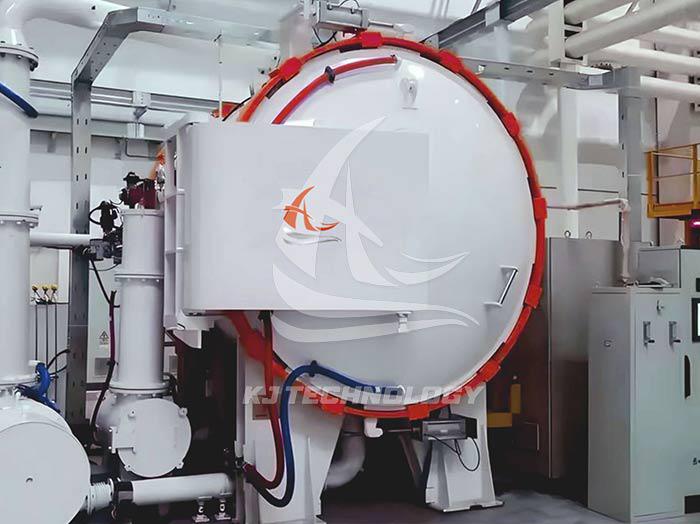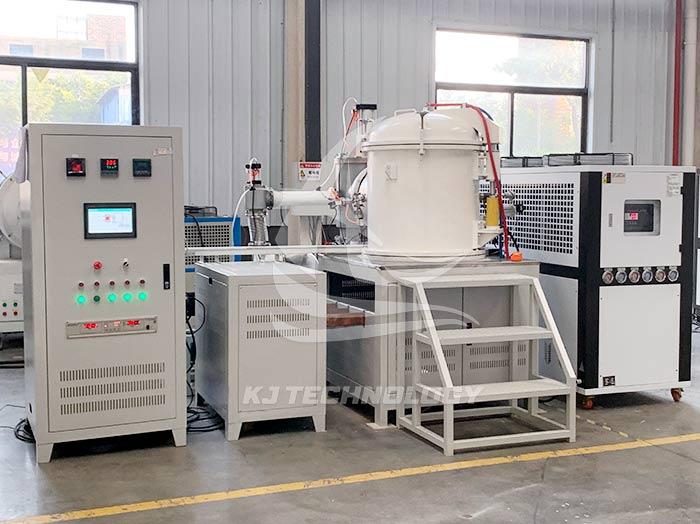Industrial large-scale vacuum electric furnace
 11-14-2025 Author: KJ technology
11-14-2025 Author: KJ technology
Industrial large-scale vacuum electric furnace is an industrial equipment that performs high-temperature heating treatment under vacuum or controlled atmosphere. It is widely used in high-end manufacturing fields such as metal processing, ceramic sintering, semiconductor manufacturing, aerospace, etc. Its core advantage lies in achieving non oxidizing and pollution-free heat treatment through vacuum environment, thereby improving material performance and product quality. The following analysis will be conducted from five aspects: working principle, structural composition, technical characteristics, application fields, and development trends:
1. Working principle
Industrial large-scale vacuum electric furnaces use a vacuum pump system to extract air from the furnace, creating a vacuum environment below atmospheric pressure (usually up to 10 ⁻ Pa or even lower), effectively isolating the effects of oxygen, nitrogen, water vapor, and other substances on materials. The heat treatment process is divided into three stages:
Vacuum pumping: Use mechanical pumps, diffusion pumps, and other equipment to reduce the pressure inside the furnace to the required vacuum level.
Heating: Use resistance wires (such as tungsten and molybdenum wires), induction heating, or electron beam heating to heat the material to the target temperature (up to 1600 ℃ or above).
Insulation and cooling: After maintaining the temperature inside the furnace for a period of time, quenching is achieved through natural cooling or rapid filling of inert gases (such as nitrogen and argon) to avoid material oxidation and decarburization.
2. Structural composition
Furnace body: made of high-quality steel or stainless steel, with high sealing and strength, and equipped with high-temperature resistant materials (such as quartz and metal alloys) inside to withstand high temperature environments. Part of the furnace body is designed with a water-cooled structure to prevent deformation due to heat.
Heating system: The core component is a resistance heating element (such as tungsten wire, molybdenum wire), which generates heat through current and heats the workpiece through radiation and conduction. Some high-end devices use induction heating or electron beam heating to achieve more precise temperature control.
Vacuum system: composed of vacuum pump, vacuum valve, vacuum pipeline, and vacuum gauge, responsible for extracting air from the furnace and maintaining the vacuum degree. Mechanical pumps are used for initial vacuuming, while diffusion pumps are used to achieve higher vacuum levels.
Control system: Adopting high-precision temperature control system (such as PID intelligent temperature control), supporting more than 30 program temperature control, can accurately set parameters such as temperature, vacuum degree, heating time, etc., to ensure process stability. Some devices are also equipped with digital twin technology to achieve fault prediction and remote monitoring.
Auxiliary system: including air inlet, exhaust outlet, observation window, etc. The air inlet can introduce specific atmospheres (such as nitrogen, hydrogen) to promote reactions or protect materials; Connect the exhaust port to the exhaust treatment device to ensure safe emissions; The observation window facilitates real-time monitoring of the situation inside the furnace.
3. Technical features
Non oxidative heat treatment: The vacuum environment completely isolates oxygen, avoiding material oxidation and decarburization, resulting in high surface cleanliness and excellent mechanical properties.
High precision temperature control: The temperature control accuracy can reach ± 1 ℃, meeting complex process requirements and ensuring consistency in material properties.
Efficient and energy-saving: With high heating efficiency, energy consumption is reduced by more than 30% compared to traditional atmospheric furnaces. Some equipment uses graphene heating elements, which improves thermal efficiency.
Multi functional integration: Breaking through the limitations of a single process, it can integrate functions such as plasma cleaning, ion nitriding, and gas quenching to meet diverse production needs.
Environmental safety: equipped with waste heat recovery system to reduce energy waste; The vacuum environment reduces the risk of explosion and ensures high operational safety.
4. Application Fields
Metal processing:
Heat treatment: Quenching, annealing, and tempering high-speed steel, titanium alloys, mold steel, etc. to improve hardness, wear resistance, and fatigue resistance.
Vacuum smelting: Smelting high-purity metals (such as tungsten, molybdenum, tantalum) and special alloys to remove impurities and improve material properties.
Ceramic sintering: promotes the densification of ceramic materials, improves mechanical properties and stability, and is suitable for hard alloys, magnetic materials, etc.
Semiconductor manufacturing: used for silicon wafer diffusion, oxidation, and integrated circuit packaging testing to reduce pollution and improve product yield.
Aerospace: Solution aging treatment of high-temperature alloy blades to enhance creep resistance and meet extreme environmental requirements.
Powder metallurgy: preparation of hard alloy parts with a density of up to 99%, such as cutting tools, molds, etc.
5. Development Trends
Intelligent upgrade: AI algorithm optimizes heating curve in real time, digital twin technology realizes fault prediction, and improves production efficiency and equipment reliability.
Green development: Popularization of waste heat recovery systems, integration of carbon footprint management technology, and assistance in the low-carbon transformation of the manufacturing industry.
Multi functional composite: integrating plasma cleaning, ion nitriding and other composite functions to meet the needs of emerging fields such as new energy and additive manufacturing.
Large scale and customization: Develop customized equipment with larger capacity and higher temperature for fields such as aerospace and nuclear energy.








